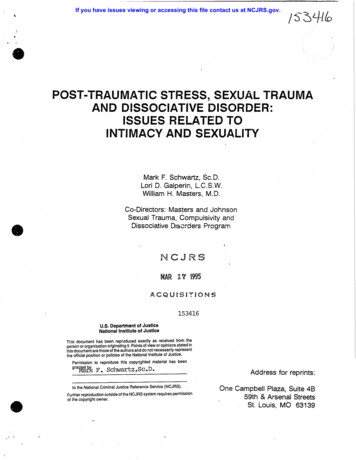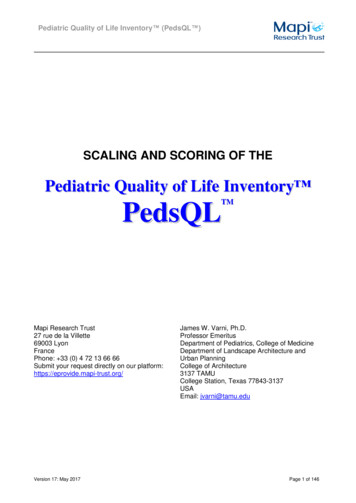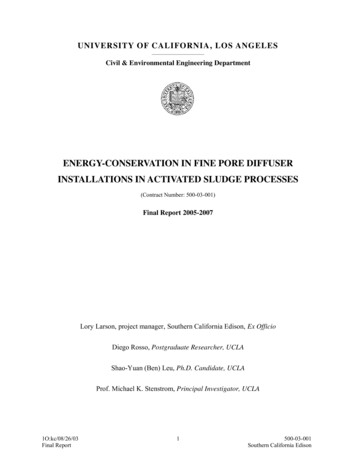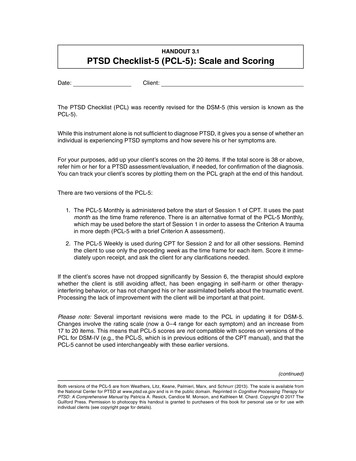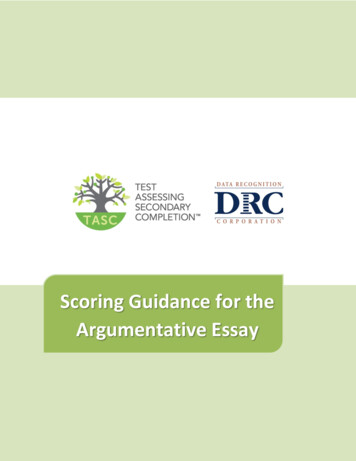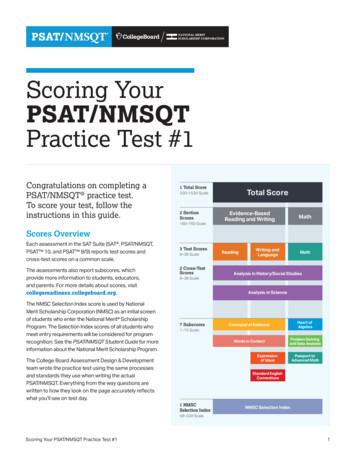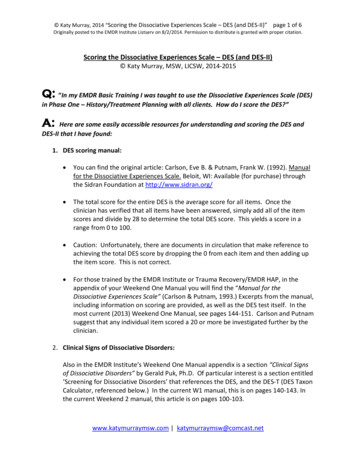
Transcription
Katy Murray, 2014 “Scoring the Dissociative Experiences Scale – DES (and DES-II)”page 1 of 6Originally posted to the EMDR Institute Listserv on 8/2/2014. Permission to distribute is granted with proper citation.Scoring the Dissociative Experiences Scale – DES (and DES-II) Katy Murray, MSW, LICSW, 2014-2015Q: “In my EMDR Basic Training I was taught to use the Dissociative Experiences Scale (DES)in Phase One – History/Treatment Planning with all clients. How do I score the DES?”A:Here are some easily accessible resources for understanding and scoring the DES andDES-II that I have found:1. DES scoring manual: You can find the original article: Carlson, Eve B. & Putnam, Frank W. (1992). Manualfor the Dissociative Experiences Scale. Beloit, WI: Available (for purchase) throughthe Sidran Foundation at http://www.sidran.org/ The total score for the entire DES is the average score for all items. Once theclinician has verified that all items have been answered, simply add all of the itemscores and divide by 28 to determine the total DES score. This yields a score in arange from 0 to 100. Caution: Unfortunately, there are documents in circulation that make reference toachieving the total DES score by dropping the 0 from each item and then adding upthe item score. This is not correct. For those trained by the EMDR Institute or Trauma Recovery/EMDR HAP, in theappendix of your Weekend One Manual you will find the “Manual for theDissociative Experiences Scale” (Carlson & Putnam, 1993.) Excerpts from the manual,including information on scoring are provided, as well as the DES test itself. In themost current (2013) Weekend One Manual, see pages 144-151. Carlson and Putnamsuggest that any individual item scored a 20 or more be investigated further by theclinician.2. Clinical Signs of Dissociative Disorders:Also in the EMDR Institute’s Weekend One Manual appendix is a section “Clinical Signsof Dissociative Disorders” by Gerald Puk, Ph.D. Of particular interest is a section entitled‘Screening for Dissociative Disorders’ that references the DES, and the DES-T (DES TaxonCalculator, referenced below.) In the current W1 manual, this is on pages 140-143. Inthe current Weekend 2 manual, this article is on pages 100-103.www.katymurraymsw.com katymurraymsw@comcast.net
Katy Murray, 2014 “Scoring the Dissociative Experiences Scale – DES (and DES-II)”page 2 of 6Originally posted to the EMDR Institute Listserv on 8/2/2014. Permission to distribute is granted with proper citation.3. Introduction to the DES by Colin Ross:http://www.rossinst.com/dissociative experiences scale.html has a great introductionto the DES.4. Clearest introduction to dissociation screening tools and specific suggestions forasking your client about dissociative experiences:My favorite “beginners guide” to recognizing and assessing dissociation is in Ross andHalpern’s 2009 book Trauma Model Therapy: A Treatment Approach for Trauma,Dissociation, and Complex Comorbidity. Manitou Communications. In the book theyprovide numerous tests for screening for and diagnosing dissociation/dissociativedisorders AND include guidance in how to actually ASK about dissociation. They eveninclude transcripts of sessions to provide an example of the kind of language you mightuse to ask clients about their experiences. On pp 19-21 they suggest: An average score of 20-30 indicates possible PTSD or DDNOSAn average score of 30 or more indicates possible DID5. Caution with extremely low scores:A client that scores ALL 0’s is someone I will screen VERY carefully for dissociation anddissociative disorders and be watchful of signs of dissociation and dissociative processesthroughout treatment The DES is full of questions asking about NORMAL dissociation –so if a client scores all zero’s, they are denying normal human experiences.6. How long to screen for dissociation and dissociative disorders:When are you “done” screening for dissociation? Never. Because the BLS in EMDRseems to dissolve dissociative barriers, I have found that quite frequently it isn’t until Ibegin the reprocessing phases of EMDR that I recognize the degree to which someonedissociates. So, even if you have “ruled out” dissociation in the past, keep watching fordissociation.7. DES subscales:Carlson, Putnam, et al (1991) identified three subscales of the DES that may be useful tothe EMDR clinician in planning for EMDR processing: Absorption and ImaginativeInvolvement (questions 2,14-18,20,22,23); Amnesia (questions 3-6, 8,10,25,26); andDepersonalization and Derealization (questions 7,11-13,27,28). The following DES FactorAnalysis document includes the DES Average, the DES T items, and the DES ng.docwww.katymurraymsw.com katymurraymsw@comcast.net
Katy Murray, 2014 “Scoring the Dissociative Experiences Scale – DES (and DES-II)”page 3 of 6Originally posted to the EMDR Institute Listserv on 8/2/2014. Permission to distribute is granted with proper citation.8. DES-Taxon:The DES-Taxon (DES-T) is an eight item measure drawn from the DES-II that determineswhether the individual score is related to pathological dissociation (Taxon), or to morenormal dissociation that likely does not indicate a dissociative disorder. The taxon isbased in Items 3, 5, 7, 8, 12, 13, 22, and 27. The probability of the individual belongingto the pathological taxon will automatically be calculated by the program. The DESTaxon Excel program is available for free in the public domain, thanks to Daryl Perry,and can be downloaded at http://www.isst-d.org/downloads/DES Taxon.xls with moreinformation available at http://www.isst-d.org/default.asp?contentID 66. To score the DES Taxon Calculator on the excel spreadsheet:o At bottom of the form you will see the tabs “Scores” “Calc.”o On the SCORES tab: After you enter all your client’s responses in column E,field E30 calculates the average DES score (as Roxanne mentioned).o On the CALC tab: Field G32 provides the calculated probability (likelihood) ofthe individual having a dissociative disorder: from 0 to 1.0. People tend toscore very close to 0 or very close to 1.00. As EMDR Institute Trainer, Gerald Puk, Ph.D. clearly states in his article “ClinicalSigns of Dissociative Disorders” (in your W1 and W2 manuals), “While the DES-T canindicate the probability that a particular individual exhibits pathological dissociativesymptoms, it provides neither a thorough assessment nor a conclusive diagnosis ofthe client’s dissociative disorder. It will be necessary to evaluate the client forthoroughly to obtain a definitive diagnosis.” (p 141) He goes on to describe otherscreening and diagnostic tests you can use for more comprehensive diagnosis.9. Learning more about dissociation:I encourage ALL EMDR therapists to learn more about dissociation. Go tohttp://www.isst-d.org to learn more about the prevalence, diagnosis, and treatmentof clients with dissociation and dissociative disorders. An article written for EMDRtherapists early in our history (1995) that is still relevant today is by EMDR Institutefacilitator and EMDRIA Approved Consultant, Sandra Paulsen, Ph.D: “Eye MovementDesensitization and Reprocessing: Its Cautious Use in the Dissociative Disorders”,available free/full-text /handle/1794/1592/Diss 8 1 6 OCR rev.pdf .10. A great article by Colin Ross on EMDR and dissociation:Colin Ross, M.D., wrote the article, “EMDR IS BASED ON A TRAUMA-DISSOCIATIONMODEL OF MENTAL DISORDERS” – soon after he was trained in EMDR. It available forwww.katymurraymsw.com katymurraymsw@comcast.net
Katy Murray, 2014 “Scoring the Dissociative Experiences Scale – DES (and DES-II)”page 4 of 6Originally posted to the EMDR Institute Listserv on 8/2/2014. Permission to distribute is granted with proper citation.free, full-text .com/publications-articles/COLINROSS.pdf11. “Eye Movement Desensitization and Reprocessing: It’s cautious Use in DissociativeDisorders (1995):An early article cautioning therapists about the use of EMDR with those that may have adissociative disorder was written by Sandra Paulsen, PhD and can be found online as afree, full-text am/handle/1794/1592/Diss 8 1 6 OCR rev.pdfOTHER RESOURCESDissociation and Dissociative Disorders:The International Society for the Study of Trauma and Dissociation (ISSTD) is a great resource. www.isst-d.org. The ISSTDGuidelines for Treating Dissociative Identity Disorder in Adults (2011) can be downloaded at http://www.isstd.org/jtd/GUIDELINES REVISED2011.pdf.Sidran Institute provides publications on dissociation. www.sidran.orgThe EMDRIA Annual Conference offers numerous workshops each year on managing dissociative processes duringEMDR and the use of EMDR with dissociative disorders. Audio recordings of the 90 minute to 6 hourworkshops can be accessed through www.emdria.org.Beere, D. B. (2003, September). The dissociative disorders: Update, current research, and applications of EMDR.Pre-conference workshop at the annual meeting of the EMDR International Association, Denver, CO.Boone, Steele, van der Hart (2011). Coping with Trauma-Related Dissociation: Skills Training for Patients and Therapists. W.W.Norton.Fine, C. G. (1996, June). EMDR-facilitated trauma work in patients with dissociative identity disorders. Paperpresented at the annual meeting of the EMDR Interational Association, Denver, CO.Paulsen, S. L. (2003, September). EMDR and ego state therapy: Energizing disowned aspects of self withdissociative table technique interwoven with EMDR. Paper presented at the annual meeting of the EMDRInternational Association, Denver, CO.Lanius, U., & Paulsen, S. (2010, September/October). Part I - Towards an embodied self: The neurobiology oftraumatic dissociation. Paper presented at the annual meeting of EMDR International Association,Minneapolis, MN.Lanius, U., & Paulsen, S. (2010, September/October). Part II - Towards an embodied self: The treatment oftraumatic dissociation. Paper presented at the annual meeting of EMDR International Association,Minneapolis, MN.Napier, N. (1993) Getting Through the Day: Strategies for Adults Hurt as Children. W.W. Norton.Rouanzoin, Curt . The Utilization of EMDR with Dissociative Symptoms Distance: The Use of EMDR with ComplexTrauma & Dissociative Symptoms. Distance Learning DVD Course available through the EMDR Institute atwww.emdr.comVermillyea, E. (2000). Growing Beyond Survival: A Self-Help Toolkit for Managing Traumatic Stress. Sidran Press.Books, chapters and journal articles that address use of EMDR with dissociative disorders include:Don Beere. (2009). An EMDR protocol for dissociative identity disorder. In M. Luber (Ed.), Eye movementdesensitization (EMDR) scripted protocols: Special populations (pp. 387-425). New York: Springer Publishing.Don Beere. (2009). Modified resource development and installation (RDI) procedures with dissociative clients. InM. Luber (Ed.), Eye movement desensitization (EMDR) scripted protocols: Special populations (pp. 281-290). NewYork: Springer Publishing.Gomez, A. (2012, May). EMDR therapy and adjunct approaches with children: Complex trauma, attachment, and dissociation.New York, NY: Springer PublishingGonzalez, A., & Mosquera, D. (2012, June). EMDR and dissociation: The progressive approach. A. I.www.katymurraymsw.com katymurraymsw@comcast.net
Katy Murray, 2014 “Scoring the Dissociative Experiences Scale – DES (and DES-II)”page 5 of 6Originally posted to the EMDR Institute Listserv on 8/2/2014. Permission to distribute is granted with proper citation.Fine, C., Paulsen, S., Rouanzoin, C., Luber, M., Puk, G., & Young, W. (2001). A general guide to the use of EMDR in thedissociative disorders: A task force report. In F. Shapiro, EMDR: Basic principles, practices and procedures, 2nd Ed. (pp.365-369) New York: Guilford Press.Fine, C.& Berkowitz, A. (2008, April). The joint use of EMDR and hypnosis in the treatment of DID, DDNOS andcomplex PTSD. Workshop presented at the 1st bi-annual European Society for Trauma and DissociationConference, Amsterdam, The Netherlands.Fine, C. (2009). The wreathing protocol: The imbrication of hypnosis and EMDR in the treatment of dissociative identitydisorder, dissociative disorder not otherwise specified, and post-traumatic stress disorder. In M. Luber (Ed.), Eyemovement desensitization (EMDR) scripted protocols: Special populations (pp. 329-347). NY: Springer Publishing.Forgash, C. A., & Copeley, M. (2008). Healing the heart of trauma and dissociation with EMDR and ego state therapy. New York,NY: Springer Publishing Co.Knipe, J. (2014). EMDR Toolbox: Theory and Treatment of Complex PTSD and Dissociation. New York: Springer Publishing.Knipe, J. (2008). “Loving eyes: Procedures to therapeutically reverse dissociative processes while preservingemotional safety.” In C. Forgash and M. Copeley, (Eds.) Healing the heart of trauma and dissociation withEMDR and ego state therapy (pp. 181-225). New York, NY: Springer Publishing Co.Knipe, J. (2009). “The method of constant installation of present orientation and safety (CIPOS).” In M. Luber (Ed.),Eye movement desensitization (EMDR) scripted protocols: Special populations (pp. 235-241). New York:Springer Publishing .Lanius, U. F., Paulsen, S. L., & Corrigan, F. M. (2014, May). Neurobiology and treatment of traumatic dissociation: Towards anembodied self. New York, NY: Springer Publishing Co.Lanius, U. F. (2005). EMDR processing with dissociative clients: Adjunctive use of opioid antagonists. In R. Shapiro (Ed.), EMDRsolutions: Pathways to healing (pp. 121-146). New York, NY: W. W. Norton & Co.Paulsen, S. L., & Lanius, U. (2009). Toward an embodied self: Integrating EMDR with somatic and ego state interventions. In R.Shapiro (Ed.), EMDR Solutions II: For depression, eating disorders, performance and more (pp. 335-388). New York,NY: W. W. Norton & Co.Paulsen, S. (2009). Looking through the eyes of trauma and dissociation: An illustrated guide for EMDR therapists and clients(269 pp.). Baindrige Island, WA: Sandra Paulsen, Ph.D.Paulsen, S. (2009). ACT-AS-IF and ARCHITECTS approaches to EMDR: Treatment of dissociative identity disorder(DID). In M. Luber (Ed.), Eye movement desensitization (EMDR) scripted protocols: Special populations(pp. 357-386).New York: Springer Publishing.Paulsen, S. L., & Lanius, U. (2009). Toward an embodied self: Integrating EMDR with somatic and ego stateinterventions. In R. Shapiro (Ed.), EMDR Solutions II: For depression, eating disorders, performance andmore (1st ed.) (pp. 335-388), NY: W. W. Norton.Paulsen, S. (2008). Treating dissociative identity disorder with EMDR, ego state therapy, and adjunct approaches in Forgash,C.A., & Copeley, M. (2008). Healing the heart of trauma and dissociation with EMDR and ego state therapy. New York,NY: Springer Publishing Co.Twombly, J. H. (2005). EMDR for clients with dissociative identity disorder, DDNOS, and ego states. In R. Shapiro (Ed.), EMDRsolutions: Pathways to healing (pp. 88-120). New York, NY: W. W. Norton & Co.van der Hart, O., Nijenhuis, E. R. S., & Solomon, R. (2010). Dissociation of the personality in complex trauma-related disordersand EMDR: Theoretical considerations. Journal of EMDR Practice and Research, 4(2), 76-92. doi:10.1891/19333196.4.2.76.van der Hart, O., Groenendijk, M., Gonzalez, A., Mosquera, D., & Solomon, R. (2013). Dissociation of the personality and EMDRtherapy in complex trauma-related disorders: Applications in the stabilization phase. Journal of EMDR Practice andResearch, 7(2), 81-94. doi:10.1891/1933-3196.7.2.81.REFERENCES:Bernstein, E. & Putnam, F. (1986) Development, reliability and validity of a dissociation scale. Journal of Nervous and MentalDisease, 174, 727-735.[Carlson and Putnam (1993) “An Update on the Dissociative Experiences Scale”, Dissociation Vol. VI, No 1, March 1993 pp 16-27.Carlson et al (1991) ”Factor analysis of the Dissociative Experiences Scale: A multicenter Study”. In B.B. Braun Y E.B.Carlson (Eds.), Proceedings of the Eighth International Conference on Multiple Personality and Dissociative States.Chicago: Rush.Chu, J.A., Loewenstein, R., Dell, P.F., Barach,P.M., Somer, E., Kluft, R.P., Gelinas, D.J., Van der Hart, O., Dalenberg,C.J., Nijenhuis, E.R.S., Bowman, E.S., Boon, S., Goodwin, J., Jacobson, M., Ross, C.A., Sar, V, Fine, C.G., Frankel, A.S.,Coons, P.M., Courtois, C.A., Gold, S.N., & Howell, E. (2005) Guidelines for treating Dissociative Identity Disorder inadults. Journal of Trauma & Dissociation, 6(4) pp. 69-149.www.katymurraymsw.com katymurraymsw@comcast.net
Katy Murray, 2014 “Scoring the Dissociative Experiences Scale – DES (and DES-II)”page 6 of 6Originally posted to the EMDR Institute Listserv on 8/2/2014. Permission to distribute is granted with proper citation.International Society for the Study of Trauma and Dissociation (2011): Guidelines for Treating Dissociative Identity Disorder inAdults, Third Revision, Journal of Trauma & Dissociation, 12:2, 115-187.Leavitt (1999) “Dissociative Experiences Scale Taxon and Measurement of Dissociative Pathology: Does the TaxonAdd to an Understanding of Dissociation and Its Associated Pathologies?” Journal of Clinical Psychology in MedicalSettings, Volume 6, Number 4, pp. 427-440 (14)Perry, D. DES Taxon Excel Program. tm.Puk, G. (2013). “Clinical Signs of Dissociative Disorders” in EMDR Institute, The EMDR Approach to Psychotherapy,Basic Training Course: Weekend One.Ross, C (1995). Diagnosis of Dissociative Identity Disorder. In Cohen, L., Berzoff, j. & Elin, M. (Eds.), DissociativeIdentity Disorder. Northvale, NJ, Jason Aronso, Inc.Ross, C. and Halpern, N. (2009). Trauma Model Therapy: A Treatment Approach for Trauma, Dissociation, and ComplexComorbidity. Manitou Communications, pp 19-21.Shapiro, F. (2001). Eye Movement Desensitization and Reprocessing: Basic Principles, Protocols, and Procedures(2nd Ed.). New York: Guilford Press.Waller, Putnam, and Carlson (1996). “Types of Dissociation and Dissociative Types: A Taxonometric Analysis ofDissociative Experiences.” Psychological Methods, 1, 300-321.Waller and Ross (1997) ”The prevalence and biometric structure of pathological dissociation in the generalpopulation: taxometric and behavior genetic findings”. J Abnorm Psychol. Nov;106(4):499-510.I hope this provides some helpful information as you use and interpret the DES with all yourclients prior to the active trauma processing phases of EMDR.Warmly,KatyEMDR INSTITUTE INTERNET DISCUSSION LIST MODERATORKaty Murray, MSW, LICSW, BCDContact katymurraymsw@comcast.net or (360) 438 0306Webpage www.katymurraymsw.comOffice 3627 Ensign Road NE, Suite B Olympia, WA 98506Board Member – www.emdrresearchfoundation.org Trainer – www.emdrhap.org EMDR Institute Listserv Moderator and Facilitator – www.emdr.com Approved Consultant – www.emdria.org Regional Coordinator - SW WA EMDRIA Regional Networkwww.katymurraymsw.com katymurraymsw@comcast.net
Halperns 2009 book Trauma Model Therapy: A Treatment Approach for Trauma, . September). EMDR and ego state therapy: Energizing disowned aspects of self with dissociative table technique interwoven with EMDR. Paper presented at the annual meeting of the EMDR . The joint use of EMDR and hypnosis


